I was working with a friend who is an amply qualified survival subject matter expert (SME) on improving a piece of content last year that was originally written by a Vietnam vet when he saw potassium permanganate in an equipment list for a Pocket Survival Kit his reaction caught my attention. “Man, that stuff’s old school.” As if to say, “Why on earth would you bring that?”
That got my attention. Previously, I had thought there are plenty of articles out there on the subject, but survival is such a broad field that encompasses a vast scope of subjects, and if it wasn’t obvious to my friend, who is a Special Operations veteran in addition to being an SME on primitive survival and bushcraft, there must be a lot of folks out there who could be benefiting from the unique properties of this multiuse survival chemical.
Disclaimer: Potassium permanganate is a powerful oxidizer and, as such, deserves an appropriate level of care in storage and handling. It should be stored in a container that it cannot react with such as plastic vial with an air-tight, plastic cap. It may react with caps containing metal foil gaskets and should not be stored in metal containers. It should not be stored near chemicals that it could react with as this could result in a fire or explosion hazard.
Like most water treatment chemicals, consuming potassium permanganate or water containing too high of a concentration of it can be toxic. Do not swallow concentrations greater than that used to treat drinking water. Concentrated solutions and repeated use may cause chemical burns.
This chemical will also brightly stain fabric, carpet, and many surfaces when combined with even the slightest amount of moisture. Do not allow contact with the eyes, mucus membranes, genitals, or the anus. It readily oxidizes finger and toenails, which is not dangerous, but can cause great alarm if the person does not understand what happened.
Lastly, like most other powerful oxidizers, potassium permanganate is a high explosive precursor. So, although this useful chemical isn’t hard to find because it has so many peaceful purposes, indiscrete purchasing, or storage of large quantities of it could draw unwanted attention or be hazardous if stored improperly.
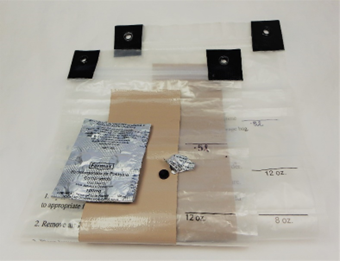
Multiuse and Powerful
Potassium permanganate, also known as “Condy’s Crystals”, has a multitude of survival uses. In use since the 1800’s, it is still important enough to be included in the WHO’s List of Essential Medicines, so this oldie is still a goodie that can treat drinking water, be used and an antiseptic, wound wash, antifungal bath, signal for rescue on snow and more.
Best of all, nearly all these uses require surprising tiny amounts of the powerful chemical, making it possible to include it in even the smallest survival kits.
Two possible obstacles to inclusion are that instructions for use of potassium permanganate appear largely qualitative in nature, such as, “For water treatment add crystals and agitate until a light pink color is achieved.”, and that studies demonstrating proof of efficacy in various roles occurred so long ago that they can be difficult to find. I didn’t want to recommend a water treatment chemical to others, even for survival use, without proof that it works, so I tracked down a medical study performed in India while researching potassium permanganate for a book which I will reference in the next section on water treatment.
Don’t be alarmed by the apparently qualitative nature of the instructions. Interestingly, increasingly stronger concentrations turn water different colors, from lighter to darker shades of pink, then red, and eventually bright purple, making it possible to judge solution strength by the color of the solution. So, different colors of potassium permanganate solution are useful for different purposes. This unique feature makes it possible to reliably judge solution strength in field conditions without test strips, unlike chlorine and iodine.
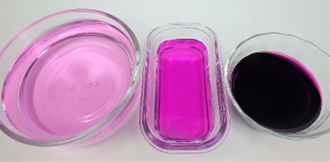
Don’t get me wrong, if I have my Go Bag with me and water treatment chemicals and a first aid kit and so on, potassium permanganate is not going to be my first choice for most applications because in many cases there are more convenient or more effective alternatives in many cases, but if I just have a Pocket Survival Kit, it’s nice to know that a small amount of one chemical can solve so many problems.
Water Treatment
Slowly mixing a few crystals (each about the size of the period at the end of this sentence) with 1-4 liters of water in a bladder or vessel, once a very faint pink color that persists for 2-8 hours means a dosage of approximately 1 in 200,000 parts has been achieved. A light pink color that persists for up to 24 hours is indicative of a dosage of approximately 1 in 100,000 parts, and a deep pink color that persists even after 24 hours indicates a dosage of 1 in 50,000 parts. At 1 in 50,000, you will also notice an objectionable taste.
The study I mentioned was published in the Indian Medical Gazette back in 1950 (Radhakrishna Banerjea M.B. May, 1950). It concluded that, even at the highest drinkable dosage, it could not be depended upon to produce water that would be considered safe bacteriological standards 100% of the time. However, it was successful in the majority of cases after a relatively long contact time of 24 hours, and a dose of 1 in 200,000 was sufficient to inactivate cholera, after an exposure time of two hours, at the concentrations it was commonly found in well water at the time.
While potassium permanganate may not be a preferred method of primary disinfection, it can still prevent most waterborne illness and if it can do that in 1950’s India, it should work in U.S. today, where I doubt you could find water with a greater concentration fecal-oral pathogens, even during a survival ordeal. So, if you can’t boil water and don’t have chlorine dioxide, potassium permanganate is still an effective water treatment option. Since a tiny vial will treat a lot of water, it makes sense to include in survival kits. Water treatment methods don’t have to render water sterile to prevent most waterborne illness.
First Aid Uses
Preventing infection is high priority during a survival ordeal and dark pink potassium permanganate solution is also useful as a topical antiseptic solution for external use and as antiseptic wound wash for cleaning out wounds.
It is also an astringent and can be used to dry out eczema. I used it to dry out mosquito bites in Brazil after I ran out of other astringents, and it worked well. At the dark pink to red concentration, potassium permanganate solution can be used to treat fungal infections in skin.
Red solution can also be used to treat canker sores and disinfect oral injuries. Be sure not to swallow red or darker solution or allow contact with the throat or mucous membranes. Rinse well with clean water after use.
Fire Starting/Incendiary Diversions
Mixing potassium permanganate with glycerin produces a powerful exothermic reaction. It is potent enough that when the Forest Service has needed to fight fire with fire in inaccessible terrain, it has injected small golf ball-like spheres filled with 3 grams of potassium permanganate with 1cc of ethylene glycol automotive coolant and air dropped thousands of the diminutive incendiaries to quickly create back burns. After a short delay (of about 30 seconds), the balls burst into a hot flame for about 2 minutes. The small incendiaries ignite the available fuel, which burns, preventing forest fires from spreading by depriving them of fuel.
I don’t recommend potassium permanganate as a go to fire starting method. There are much easier ways to start a campfire and if you carry potassium permanganate in your Pocket Survival Kit, you probably have other tools to start a fire. But if you didn’t have a survival kit but did have a first aid kit that contained potassium permanganate, you might as well know that it can be mixed with glycerin, used to start a fire.
Glycerin is a sugar alcohol that occurs naturally during fermentation of beer, honey, wine, and vinegar. Because your body can’t fully absorb it, it can cause diarrhea and gas. It can be used as an ingredient in skin moisturizers and medicinal balms to help mix oil and water, and as a laxative suppository for constipation. So, it has medical uses, but not so many that it is commonly included in modern first aid kits.
In the exothermic reaction, potassium permanganate is the oxidizer or the source of oxygen for the fire. A molecule of potassium permanganate has double the oxygen atoms available as an elemental oxygen molecule in the air (4 to 2) and packs them more densely. The glycerin is a source of carbon-hydrogen bonds or the fuel in the fire triad. Heat, the last leg of the triad necessary for fire, is produced as the potassium permanganate oxidizes glycerin.
At first, the mixture will smoke, but within minutes, it will burst into flame. This delay is useful when a delayed incendiary or time delay is needed to create a diversion. Because a small volume of ingredients is needed to create the reaction, they are easily carried or smuggled by prisoners.
Faking Illness to Facilitate Escape
People have used potassium permanganate to fake illness, which is a tactic that has been used by hostages to gain release, obtain medical treatment, or convince guards that they are incapable of escape, causing them to drop their guard.
Signaling on Snow
Red or purple solution makes an excellent signal on snow-covered terrain. Fill a plastic bag or water bladder with bright solution, fit a squirt cap or punch a few pinholes in a water bladder or plastic water bottle cap or in the corner of a plastic bag and you can write a brightly colored, highly visible message on snow.


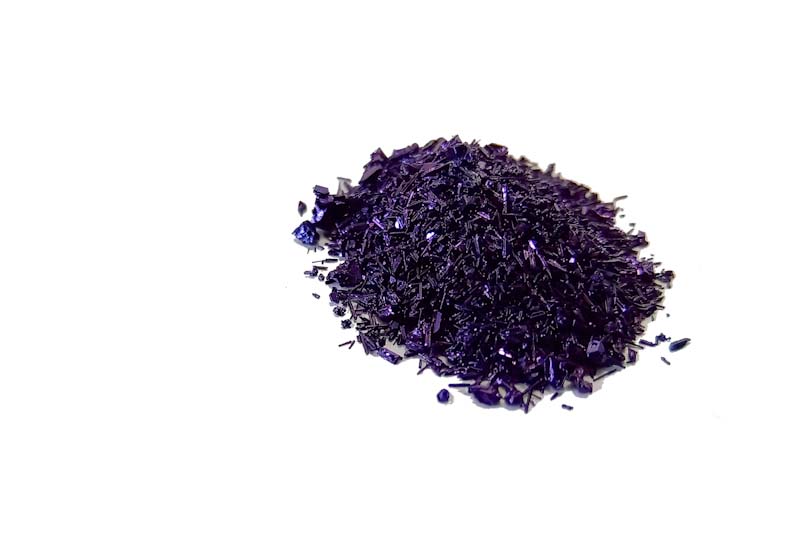

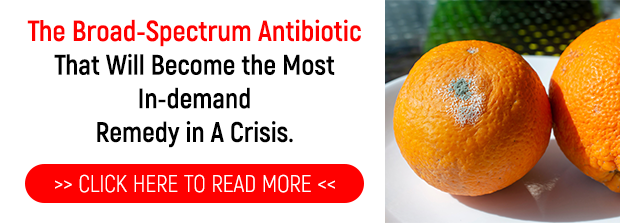



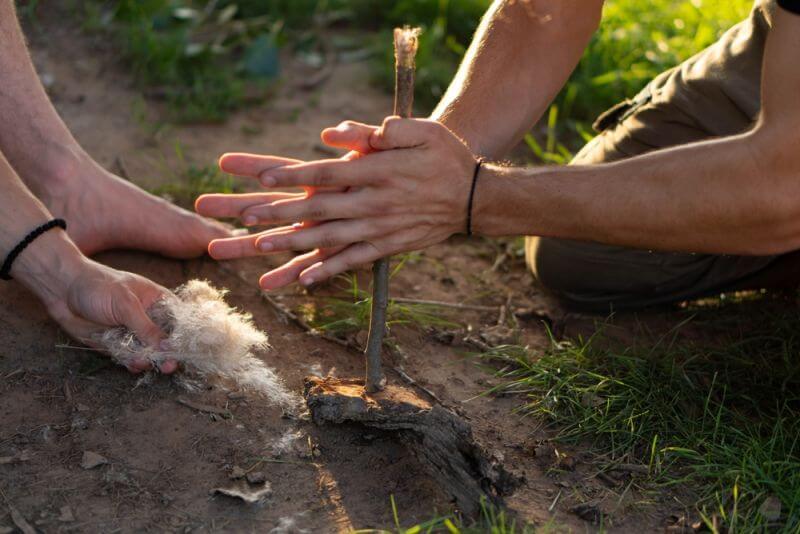

Shaun | April 29, 2023
|
In my mini-kit, I have small plastic containers, a bit smaller than the film canister of old. One black, one white. In the black one I keep some potassium permanganate, in the white one I keep table sugar. Similar to the glycerin, if you mix these two, it will also get a chemical reaction to start a fire, you just have to add a little friction to the mix. Put the two together and grind them, as if in a mortar and pestle, and presto, the same sparking, fizzing flame up occurs. (You can simply do this on a flat rock, for example).
This avoids keeping the glycerin from potentially spilling and being a problem in the tiny kit. In the event of a spill, there’s less chance of accidental flame up.
The same mini kit has a lighter with a bit of duct tape and a tiny bit of old inner tube on it, the inner tube keeps the fuel release tab from accidentally being depressed. Some people know duct tape is pretty good as a “tinder”, some may not.
I do keep glycerin and pot.perm in my bigger grab and go bag. Along with Bic style lighters and a ferro rod, it’s yet another compact way to create the life saving fire we all need to be able to generate. A small handful of waterproof matches round out the options.
This is just an added multi purpose item in the kit, good for both “fire and water”!!!
Thanks for the article, it gives the younger or less informed of us additional protection against having a premature expiration date.;-)
john silvers | April 29, 2023
|
Shaun…..Great info, thank you!!
Cache Valley Prepper | June 12, 2023
|
Thanks for your comments Shaun! Sugar with heat from friction can work, as can glycol-based radiator fluid.
john silvers | April 29, 2023
|
Thank you Cache Valley Prepper!! All you articles are top notch.
Shaun | April 29, 2023
|
John, there are a lot of people who are reading this stuff, I imagine, and most of us can add SOMETHING to the discussion, I’m glad when I’m in a position to offer something to others to help.
If it helped YOU, then I can feel like I contributed a little bit. You may end up doing something similar one day. I sure as hell hope so. 😉
John Silvers | April 30, 2023
|
Giving back, being a giver and not a taker is part of the deal in my opinion. I’m a builder and a farmer and contribute my knowledge whenever I see an opportunity.
There are many areas I do not have the same depth of knowledge and appreciate other’s sharing theirs. I show that appreciation by responding with a thank you.
Cache Valley Prepper | June 12, 2023
|
Anytime John! Thank you for reading and commenting. It’s always good to hear that people are reading and enjoying what they read.
John silvers | April 30, 2023
|
In other words, Shaun, take the compliment and leave the sermons to the preachers.
Shaun | April 30, 2023
|
Thanks and “AMEN!” 😉